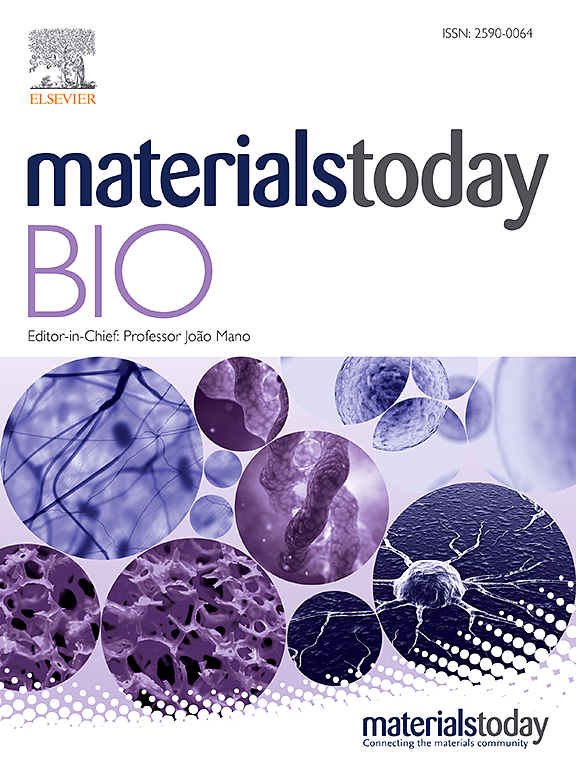近红外触发铜掺杂氮化碳纳米复合材料诱导多米诺骨牌效应协同肿瘤治疗和免疫微环境重编程
IF 10.2
1区 医学
Q1 ENGINEERING, BIOMEDICAL
引用次数: 0
摘要
利用协同相互作用的多模式靶向联合疗法已成为肿瘤学的一种变革范例,逐渐取代传统的单一疗法。我们在此报道了一种基于铜掺杂石墨相氮化碳的近红外(NIR)光触发多功能纳米复合材料(命名为CNCu@HA),它通过诱导细胞凋亡、铜增生和免疫原性细胞死亡(ICD)有效地消除肿瘤,同时启动强大的免疫反应。具体来说,铜离子的掺入增强了近红外光吸收,有效地分离了电子-空穴对。此外,铜离子表现出类芬顿反应能力。因此,CNCu@HA引发的多米诺骨牌效应不仅实现了对肿瘤细胞的光热消融,还起到了双重芬顿样催化剂和光敏剂的作用,产生过多的活性氧(ROS)和谷胱甘肽(GSH)的消耗。这一过程增强了化学动力治疗(CDT)和光动力治疗(PDT)的协同作用,促进肿瘤细胞凋亡。由此产生的细胞内氧化应激过载损害线粒体功能,下调ATP水平,抑制ATP依赖性热休克蛋白的表达,从而同步增强轻度光热疗法(mPTT)的治疗效果。此外,ATP水平降低阻碍铜离子外排,导致细胞内铜离子积累。Cu2+与内源性过氧化氢(H2O2)反应生成O2和Cu+,缓解肿瘤内缺氧,增加癌细胞对cuprotosis的易感性。这些CNCu@HA-induced细胞毒性作用触发icd驱动的树突状细胞成熟、M1巨噬细胞极化和CD8+ T细胞浸润。这一过程激活了多层级联的协同相互作用,增强了免疫反应,重塑了肿瘤免疫微环境,并实现了多米诺骨牌治疗效应,在体外和体内模型中都显示出显著的抗肿瘤功效。本文章由计算机程序翻译,如有差异,请以英文原文为准。

Near-infrared-triggered copper-doped carbon nitride nanocomposite inducing domino effect for synergistic tumor therapy and immune microenvironment reprogramming
Multimodal targeted combination therapies harnessing synergistic interactions have emerged as a transformative paradigm in oncology, gradually superseding conventional monotherapies. We herein report a near-infrared (NIR) light-triggered multifunctional nanocomposite based on copper-doped graphitic-phase carbon nitride (named CNCu@HA), which efficiently eliminates tumors by inducing apoptosis, cuproptosis, and immunogenic cell death (ICD) while initiating robust immune responses. Specifically, the incorporation of copper ions enhances NIR photoabsorption and effectively separates the electron-hole pairs. Moreover, copper ions exhibit Fenton-like reaction capabilities. Consequently, the triggered domino effect of CNCu@HA not only achieves photothermal ablation of tumor cells but also functions as a dual Fenton-like catalyst and photosensitizer, generating excessive reactive oxygen species (ROS) and depleting glutathione (GSH). This process enhances the synergistic efficacy of chemodynamic therapy (CDT) and photodynamic therapy (PDT), promoting tumor cell apoptosis. The resultant intracellular oxidative stress overload impairs mitochondrial function, downregulates ATP levels, and suppresses ATP-dependent heat shock proteins expression, thereby synchronously augmenting the therapeutic effect of mild photothermal therapy (mPTT). Additionally, reduced ATP levels impede copper ion efflux, leading to intracellular copper ions accumulation. Cu2+ react with endogenous hydrogen peroxide (H2O2) to produce O2 and Cu+, alleviating intratumoral hypoxia and increasing cancer cell susceptibility to cuproptosis. These CNCu@HA-induced cytotoxic effects trigger ICD-driven dendritic cell maturation, M1 macrophage polarization, and CD8+ T cell infiltration. This process activates a multilayered cascade of synergistic interactions, potentiating the immune response, reshaping the tumor immune microenvironment, and achieving a domino therapeutic effect, demonstrating remarkable antitumor efficacy in both in vitro and in vivo models.
求助全文
通过发布文献求助,成功后即可免费获取论文全文。
去求助
来源期刊

Materials Today Bio
Multiple-
CiteScore
8.30
自引率
4.90%
发文量
303
审稿时长
30 days
期刊介绍:
Materials Today Bio is a multidisciplinary journal that specializes in the intersection between biology and materials science, chemistry, physics, engineering, and medicine. It covers various aspects such as the design and assembly of new structures, their interaction with biological systems, functionalization, bioimaging, therapies, and diagnostics in healthcare. The journal aims to showcase the most significant advancements and discoveries in this field. As part of the Materials Today family, Materials Today Bio provides rigorous peer review, quick decision-making, and high visibility for authors. It is indexed in Scopus, PubMed Central, Emerging Sources, Citation Index (ESCI), and Directory of Open Access Journals (DOAJ).
 求助内容:
求助内容: 应助结果提醒方式:
应助结果提醒方式:


